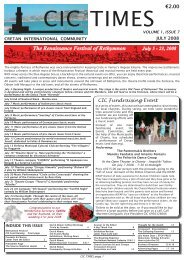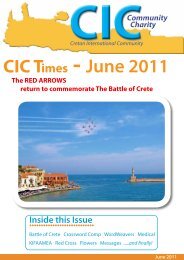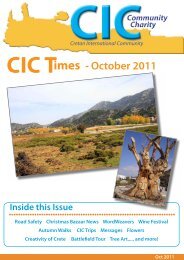CIC Times - May 2012 imes - May 2012
CIC Times - May 2012 imes - May 2012
CIC Times - May 2012 imes - May 2012
You also want an ePaper? Increase the reach of your titles
YUMPU automatically turns print PDFs into web optimized ePapers that Google loves.
Bronze Age Crete in 50 Objects - continued•••••••••••••••••••••••••••••••••••••19 <strong>May</strong> <strong>2012</strong>Katalimata at the Chagorge mouthPots from KatalimataNowicki argues that the cause of such insecurity becomes plainer in the succeeding period (FNIV, 3300-3000 BC). Now an influx of novel cultural customs and materials can be detected all overthe island, most typically being concentrated first on the coasts. Here the new foundations have adefensive quality in their placement within the landscape, enhanced by suitably placed walls of piledup boulders. The south coast is heavily represented: most densely at the south-east corner (fromZakros, clockwise around to Goudouras) where some 25 or more settlements are known. Settling oncoastal ridges and promontories, the pioneers later pushed up gorges towards the interior uplands.Another cluster of a dozen villages is concentrated for a few miles either side of the Plakias bay,with a handful more (3) at the very south-west extreme of Crete. Nowicki wonders whether offshoreislets (e.g. Gaidouronisi and Koufonisi) acted as the primary bridgeheads: they were open andundefended, but were certainly inhabited too. (Early Iron Age Euboeans adopted a comparable tacticwhen establishing mercantile colonies off the Tuscan coast of Italy.)Site 14: protected by cliffs and wallSettlements in the SE corner of Crete






